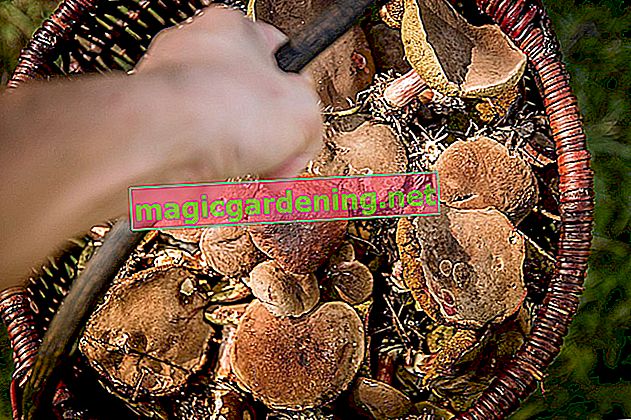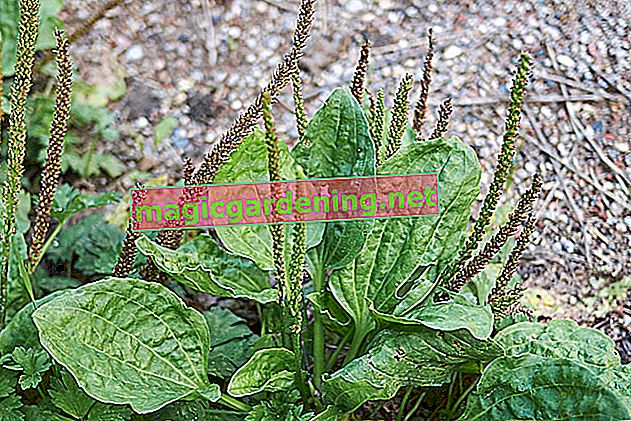
Why is a dragon tree compatible with pruning?
At first glance, a dragon tree looks like a palm or a multi-stemmed tree. In fact, dragon trees (Dracaena) are an important genus within the asparagus family . Depending on the species, the evergreen houseplants thrive with one or more woody stems that are adorned with a decorative tuft of sword leaves.
also read
- How to cut butterfly lilacs correctly - tutorial for the perfect cut
- Exemplary cutting of a snowball - tutorial for the perfect cut
- Water the dragon tree properly
A dragon tree is therefore distantly related to the popular vegetable asparagus or widespread ornamental plants such as the star of the milk or the hare bells. Regardless of the many differences, the asparagus family is characterized by a high degree of cut tolerance .
background
Sleeping eyes - secret recipe for growing out of nothing
If you cut off a trunk on the dragon tree, two new shoots will grow at this point, similar to multi-headed dragons in myths and legends. In Dracaena species, growth has nothing to do with magic, but is based on the ingenious botanical property of freshly sprouting from sleeping eyes. Gardeners refer to dormant buds as the sleeping eye, which are created as an iron reserve in proportion to the growth in height. If important parts of the plant, such as shoots and trunks, fall out, sleeping eyes are activated. Your only job is to replace the lost plant volume. Since a dragon tree thrives with opposing buds, there are always two fresh shoots that seem to sprout out of nowhere after pruning.Prepare the cut correctly - tips & tricks
As befits a dragon tree, it is permeated with dragon blood in the form of reddish sap. Since ancient times, a red-colored resin that is obtained from various types of dragon trees has been called dragon blood. The sap is correspondingly sticky and intensely colored . In connection with a cut, dragon blood can cause irreversible stains on materials, floors and clothing. A high saponin content also harbors the risk of annoying itching if the sap comes into direct contact with the skin. The following prep work is a good idea before you cut your dragon tree:
- Sharpen, clean and disinfect scissor blades with alcohol
- Swap the old, blunt saw blade for a new, sharp saw blade on the folding saw (€ 17.70 at Amazon *)
- Place the dragon tree on foil, old blankets or used curtains
- Put on gloves and stain-resistant clothing
- Keep cotton balls or torn paper tissues close at hand to catch the sap
Do not prune a dragon tree on valuable wood, stone or carpet flooring. If covering the floor is too laborious for you, move the cutting work outside to a shady place in the open earth.
Cut back the dragon tree
The best time to cut the dragon tree is early spring . At the end of the winter dormancy, the green plant prepares for the new vegetation period from February / March, is accordingly vital and willing to shoot. The evergreen indoor tree makes it easy for the gardener to cut, because any former leaf attachment is suitable as an interface . After the recommended preparations, here's how to prune your dragon tree:
- Place scissors or a saw just above a former base of the blade
- Stabilize the shoot or trunk with one hand
- Cut or saw with the other hand in one go to leave cuts as smooth as possible
- Dust cuts with charcoal or cinnamon
- Apply a thin layer of tree wax to the edges of large cuts with a diameter of more than 2 cm
- Catch strong sap with cotton balls or paper tissues
As the illustration below shows, you can't go wrong with pruning dragon trees. Along the lignified shoots and trunks there is a large number of earlier leaf attachments from which fresh shoots can grow. The further down you start the cut, the longer it will take to sprout again. If you prune an old dragon tree by more than half, please be patient for several weeks until growth begins. It is beneficial for the process if you then repot the green plants in fresh substrate.

Digression
Revitalize clippings instead of throwing them away
The clippings are far too valuable to be disposed of in the garbage or on the compost. Cut leaves and trimmed stems are perfectly suited as vital propagation material. Place one or more stem cuttings in a glass of soft water. In the bright, warm location you can see up close how the offshoots take root below and sprout splendidly above. Once the root strands have reached a length of several centimeters, pot your pupils individually, as a duo or trio in pots with slightly acidic, well-drained potted plant soil.Do not cut off dead leaves
Dead leaves on the dragon tree are no match for scissors. The term evergreen foliage does not imply that a single leaf within the crown will live forever. As a rule, a sword blade moves in after two to three years. In exchange for this, a fresh leaf usually sprouts in the foreleg, so that the volume of foliage is not reduced.
Please do not cut off a dead leaf. The remaining tissue rots and becomes a source of infection for diseases. Instead, wait for a dragon tree leaf to completely die off. The plant either releases the leaf by itself by shedding it. Alternatively, a brave jerk is sufficient to remove the worn sword blade from the trunk without leaving any residue.
frequently asked Questions
Is a dragon tree poisonous?
Some of the popular dragon tree species are classified as slightly poisonous. The plants contain saponins and other toxins which, if consumed, can cause nausea, vomiting and cramps. Children, sensitive adults and pets are affected. Furthermore, skin contact with the reddish sap can cause allergic reactions which are associated with annoying itching. Asthmatics experience difficulty breathing when exposed to dragon tree fumes for long periods of time.
Hibernating a dragon tree outside - is that possible?
All dragon tree species are native to tropical and subtropical regions. As a result, the evergreen indoor trees have not learned to survive in winter frosts. The popular Canary Islands dragon tree (Dracaena draco) is one of the most cold-tolerant species and can withstand temperatures close to freezing for a short time without damage. From April to October, a dragon tree enjoys fresh air and sunshine on the balcony and terrace. If the temperatures drop below 10 degrees, it is of course time for the exotic green plants to find frost-free winter quarters.
Can a dragon tree bloom? If so, what do the flowers look like?
Under ideal conditions, it is quite possible that a dragon tree will bloom. If you are given the rare honor, you can look forward to a decorative inflorescence, which consists of countless, large, white bell flowers that spread a seductive scent. If pollinating insects get to the flowers, they turn into orange berries. The fruits are beautiful to look at, but not suitable for consumption.
Which dragon tree varieties are suitable for the bright living room?
The favorite of all carpenters is undoubtedly the Canary Islands dragon tree (Dracaena draco) with a majestic height of 300 to 400 centimeters, a magnificent trunk and sword-shaped leaves up to 50 centimeters long. Dracaena fragrans makes the Canary Islands dragon tree the most popular dragon tree with a height of 150 to 200 centimeters and colored or striped ornamental leaves. The multi-stemmed beauty with the botanical name Dracaena marginata is no less decorative. Its narrow, lanceolate leaves are up to 40 centimeters long and gather in elegantly curved leaf cups. Dracaena hookerana exudes a cozy jungle atmosphere, whose leathery-green sword leaves grow up to 70 centimeters long and 7 centimeters wide.
Cut off brown leaf tips on the dragon tree or not?
With brown leaf tips, a dragon tree indicates that the humidity is too low. You can cut off the damaged areas with sharp scissors. It is important to note that you leave a tiny brown remnant of tissue and do not cut into the green leaf mass. We then recommend increasing the humidity in the room or regularly spraying the dragon tree with soft water.
The 3 most common mistakes
If a dragon tree no longer sprouts after it has been pruned or causes worries with moldy cuts, the carpenter has made a typical cutting error. The following table names the three most common mistakes when cutting, points out classic damage patterns and gives tips for prevention:
| Cutting errors | Damage | prevention |
|---|---|---|
| cut under blazing sunlight | Dried, resin-bonded cut without budding | always prune in a shady location |
| dead, yellow or brown leaves cut off | Spread of rot from the cuts | Tear off the drawn-in dragon tree leaves |
| blunt cutting tool used | Frayed cuts, infestation with diseases and pests | Sharpen blades and cutting edges freshly and disinfect them before cutting |
Tips
The lucky bamboo proves the versatility of Dracaena species. Also known under the name Lucky Bamboo, the trendy houseplant is not a bamboo. Rather, the evergreen lucky charm with the botanical name Dracaena braunii syn comes from. sanderiana to the genus of the dragon trees. As a result, the artful green plant is endowed with a good-natured cut tolerance, which brings diverse training options with it.








